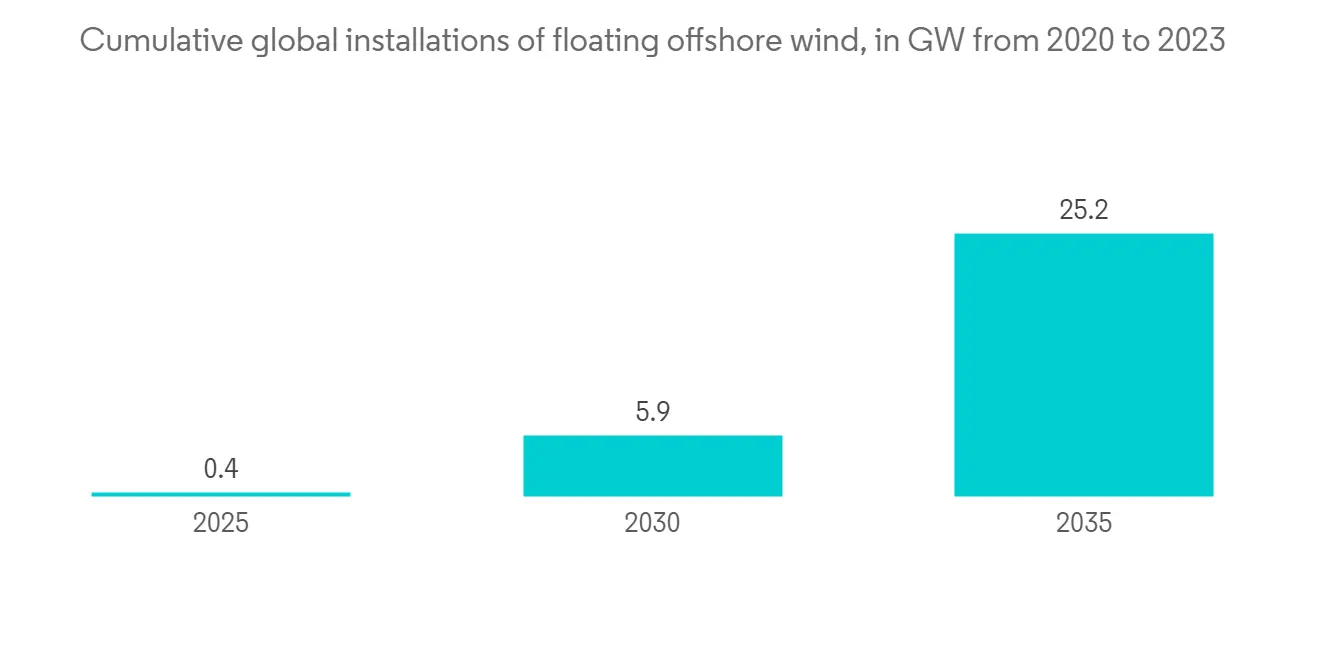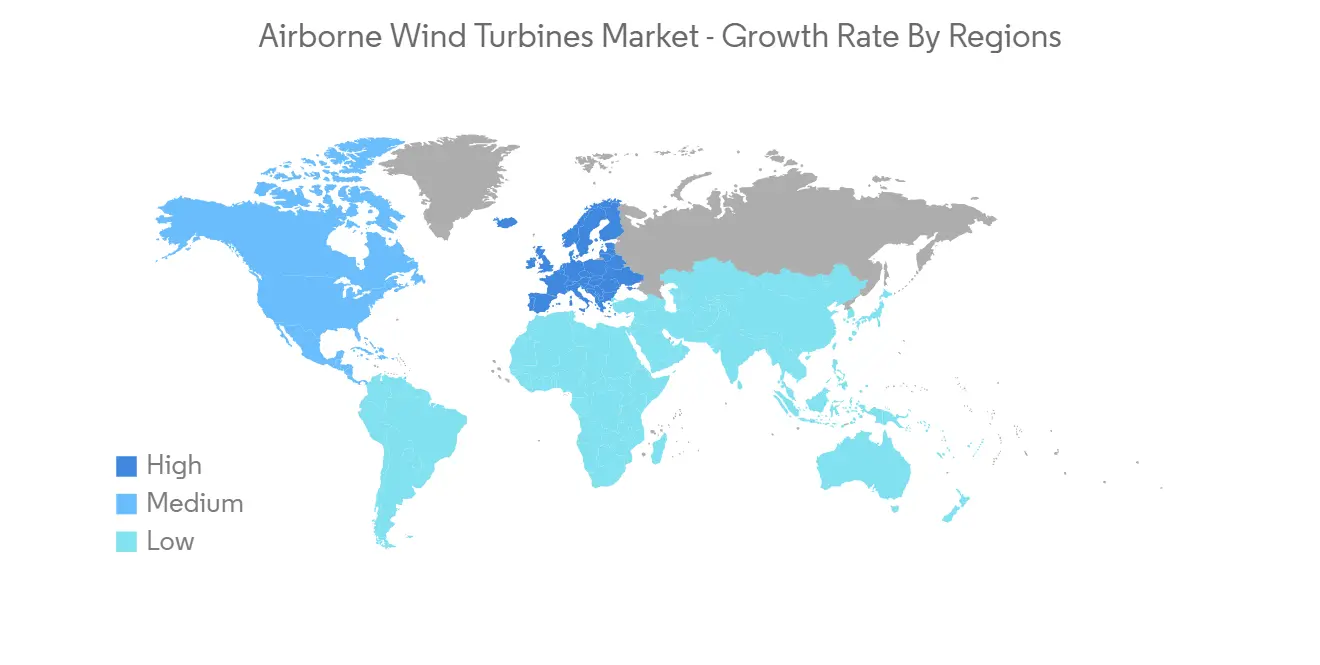 |
市場調査レポート
商品コード
1331319
空中風力タービン市場規模・シェア分析- 成長動向と予測(2023年~2028年)Airborne Wind Turbines Market Size & Share Analysis - Growth Trends & Forecasts (2023 - 2028) |
||||||
● お客様のご希望に応じて、既存データの加工や未掲載情報(例:国別セグメント)の追加などの対応が可能です。 詳細はお問い合わせください。
| 空中風力タービン市場規模・シェア分析- 成長動向と予測(2023年~2028年) |
|
出版日: 2023年08月08日
発行: Mordor Intelligence
ページ情報: 英文 120 Pages
納期: 2~3営業日
|
- 全表示
- 概要
- 目次
空中風力タービン市場規模は、2023年の1億2,981万米ドルから、予測期間(2023年~2028年)のCAGR 9.09%で、2028年には2億56万米ドルに成長すると予測されます。
世界の風力タービン市場には大きな潜在力と需要があるため、企業は新技術に投資し、このグリーン技術を効果的に利用する製品を投入しなければならないです。迅速で信頼性の高い電力を必要とする軍事任務も災害救援任務も、まもなく風力エネルギーで賄われるようになるかもしれないです。
風力タービンの損傷や異常を発見するには、継続的な検査が必要です。タービンの損傷は発電能力を低下させ、騒音を増加させるため、ローターブレードの付着物は定期的な清掃が必要です。こうした損傷を発見するためには、技術者による定期的な検査が欠かせないです。風力タービンのメンテナンス・コストを削減し、正常な状態からの逸脱を早期に発見するために、風力タービンの健全性を継続的にチェックする自動化手法が生み出されつつあります。
東芝は、発電所のタービン発電機用のロボット検査サービスを商品化しました。このロボットは、火力・原子力発電所の事業メンテナンスサービス専用に設計されています。この多用途ロボットは、タービンローターのくさびや歯の内部欠陥を超音波で検査するプローブも備えています。
COVID-19パンデミックやロシア・ウクライナといった不確定要素は、エネルギー需要と消費に劇的な影響を与えました。こうした課題にもかかわらず、発電技術は危機に強いことを示しました。主要部門は、再生可能エネルギーの費用対効果の高さを実感しました。ENGIE Laborelecは、ドイツのStorengyガス貯蔵施設のAquilonプロジェクトに参加し、その運営を脱炭素化しました。このプロジェクトでは、巨大な凧を使って風力タービンよりも高い高度で風力エネルギーを利用するSkySails空中風力エネルギー(AWE)ソリューションが使用されました。
AWEシステムにおける風力エネルギーの技術的資源ポテンシャルには不確実性があり、これは商業的設計のエネルギー収集能力に依存するため、クライアントが空中風力タービンに迅速に投資することを妨げる可能性があります。AWE技術は基本的に新しいものであり、国家レベルで意味のある規模で展開するには、さらなる大幅な開発が必要です。
空中風力タービンの市場動向
洋上アプリケーションが空中風力タービン市場で大幅な成長を遂げる
洋上風力発電の増加は、化石燃料への依存を減らし、ネット・ゼロへの道を加速するチャンスです。洋上エネルギーの可能性は、次のような例で理解できます。GE Haliade-X 12MW洋上風力タービンの1回転は、英国の平均的な家庭の24時間分の電力を供給するのに十分なエネルギーを生み出します。
洋上風力発電所は、化石燃料への依存を減らし、エネルギー転換を加速させるために、各国がますます洋上風力発電に注目する中、その規模の大きさで世界の話題となっています。
ウッド・マッケンジーの報告書によると、大規模風力発電所の世界容量は、2020年の34GWから2030年には330GWに増加すると予想されています。米国バイデン政権は、2035年までに浮体式技術のコストを最大70%削減し、容量を500万世帯分の電力に相当する15GWまで増加させることを目指しています。
デンマークのエネルギー企業であるOrsted社は、英国ヨークシャー沖で世界最大の固定底洋上風力発電所Hornsea 2を開発しました。これらの洋上風力発電所を合わせると250万世帯に電力を供給することができ、2030年までに50GWの洋上風力発電容量を確保するという英国政府の目標に貢献します。
2022年10月現在、約50基の浮体式洋上風力タービンが稼動しているに過ぎず、世界のストックは2030年までに5GW、2035年までに25GWを超えると予想されています。
Mammoetは、浮体式洋上風力タービン市場における新たなソリューションの開発に取り組む様々な企業の製品革新の可能性を見極めるため、Offshore Wind イノベーターコンテストを開催しました。コンテストの最終選考に残ったスカイリフターは、250トンを吊り上げる空中クレーンを発表し、2,000キロメートル以上の距離で機械部品やブレードのメンテナンスを行っています。

欧州が空中風力タービン市場を独占
欧州の陸上風力発電容量は207GWで、欧州委員会はネット・ゼロ・ビジョンの一環として2050年までに1,000GWまで増やすビジョンを掲げています。この需要に対応するため、より多くの風力発電用地を開拓することが、同地域の空中風力タービン市場の成長を促進することになります。
AWEは、既存の風力技術よりも低コストでエネルギーを供給できます。2030年代初頭までには、AWEは既存の風力技術よりも低い平均価格で競争できるようになると思われます。300~500メートルまでの潜在的な風力資源をより多く収穫することで、AWEは既存の風力技術では実現不可能な、より多くの場所で実行可能です。
欧州を中心に約20の小さな会社がAWE用の装置を開発しており、2025年までに地上システムを商業的に稼働させたいと考えている会社もあります。ノルウェー・オフショア・ウィンド・クラスター(Norwegian Offshore Wind Cluster)とそのメンバーとの協力で、マカニはメセンタ試験場の海上を飛ぶエネルギー凧の試験を行っています。ノルウェー・オフショア・ウィンド・クラスターとそのメンバーとの協力で、MakaniはMetcentreテストサイトで海の上を飛ぶエネルギー凧の試験を行っています。

空中風力タービン産業概要
空中風力タービン市場は、GE Power、Enercon GmbH、Nordex SE、Siemens AGなどの主要企業が参入しており、競争は中程度です。これらの企業は、市場シェアを獲得し、サービス提供範囲を拡大するために、様々なアプリケーションに投資しています。企業は、合弁事業、合併、買収を活用することで、市場競争を維持しています。
2023年1月、ドイツの監査・認証サービス会社であるTUV SUDは、インドの風力発電会社にサービスを提供する契約をVentus Groupと締結しました。この契約の一環として、2社はインドのエネルギー企業に対し、風力発電機(WTG)を利用した風力発電所や風力タービンの性能を測定、分析、最適化する技術で支援します。顧客は、既存および将来の風力エネルギー投資から安全性と生産量を最大化するためのガイダンスを得ることになります。
2022年10月、シーメンス・ガメサはエアボーンと、複合材洋上風力タービンブレード製造のための自動化システムのエンジニアリングと供給に関する契約を締結しました。このプロジェクトでは、風力タービンブレードの製造、ハイブリッド加工、自動化に重点が置かれます。
2022年2月、英国の新興企業であるWindswept社は、自律的なカイト・タービン運転の実行可能性を実証するため、Shell GameChangerプログラムに採択されました。このプロジェクトでは、カイト・タービンのスケーリングの可能性とオフショア展開の必要性を評価します。新しい性能データ、制御システム、ハンドリング機器のイントロダクションより、以前は人間が操作していた打ち上げと着陸のオペレーションが、より安全で信頼できるものになります。
その他の特典:
- エクセル形式の市場予測(ME)シート
- 3ヶ月間のアナリスト・サポート
目次
第1章 イントロダクション
- 調査の成果
- 調査の前提
- 調査範囲
第2章 調査手法
第3章 エグゼクティブサマリー
第4章 市場力学
- 市場概要
- 市場促進要因と市場抑制要因のイントロダクション
- 市場促進要因
- 新興国における電力消費の増加
- 低メンテナンスの風力エネルギー技術
- 市場抑制要因
- タービンの建設・設置コスト
- 業界の魅力度-ポーターのファイブフォース分析
- 新規参入業者の脅威
- 買い手/消費者の交渉力
- 供給企業の交渉力
- 代替品の脅威
- 競争企業間の敵対関係の強さ
第5章 市場セグメンテーション
- 技術別
- 大型タービン(3MW以上)
- 小型タービン(3MW未満)
- 用途別
- オフショア
- 陸上
- 地域別
- 北米
- 米国
- カナダ
- 欧州
- 英国
- ドイツ
- フランス
- その他欧州
- アジア太平洋
- 中国
- 日本
- インド
- その他アジア太平洋地域
- ラテンアメリカ
- 中東
- 北米
第6章 競合情勢
- 企業プロファイル
- Vestas Wind Systems A/S
- Nordex SE
- Enercon GmbH
- GE Power
- Siemens AG
- Senvion S.A.
- Goldwind
- United Power Inc
- Envision Energy
- Suzlon Energy Ltd.
第7章 投資分析
第8章 市場機会と将来動向
The Airborne Wind Turbines Market size is expected to grow from USD 129.81 million in 2023 to USD 200.56 million by 2028, at a CAGR of 9.09% during the forecast period (2023-2028).
With the huge potential and demand in the global wind turbine market, companies must invest in new technologies and introduce products that effectively use this green technology. Both military and disaster relief missions, which require quick and dependable electricity to function, might be powered by wind energy shortly.
Continuous inspection is necessary to spot damage and anomalies in wind turbines. Deposits on rotor blades require periodic cleaning, as damage to a turbine reduces its capacity to generate power and raises its noise output. Periodic inspection by technicians is a must to detect these damages. Automated methods are being created to continuously check the health of wind turbines to lower the cost of maintaining them and to help identify deviations from the norm as soon as feasible.
Toshiba launched its commercialized robot inspection services for power plant turbine generators. These robots are designed exclusively for thermal and nuclear power plant business maintenance services. The versatile robot also has a probe that uses ultrasound to check for interior flaws on the wedge and teeth of a turbine rotor.
The uncertainties, such as the COVID-19 pandemic and Russia-Ukraine, drastically affected energy demand and consumption. Despite these challenges, power generation technology showed its resilience to crises. Major sectors realized the cost-effective nature of renewable energy. ENGIE Laborelec participated in the Aquilon project at a Storengy gas storage facility in Germany to decarbonize its operations. The project used the SkySails airborne wind energy (AWE) solution, which harvestsed wind energy at greater altitudes than wind turbines by using a giant kite.
There is uncertainty over the technical resource potential of wind energy for AWE systems, as this will rely on the energy-harvesting capabilities of commercial designs, which can prevent clients from making quick investments in Airborne Wind turbines. AWE technologies are fundamentally new and require significant further development before being deployed at meaningful scales at the national level.
Airborne Wind Turbines Market Trends
Offshore Application to Have Substantial Growth in the Airborne Wind Turbines Market
Increasing offshore wind power is an opportunity to reduce dependence on fossil fuels and accelerate the journey to net zero. The potential of offshore energy can be understood with the stated example. One GE Haliade-X 12MW offshore wind turbine rotation produces enough energy to power the average UK home for 24 hours.
Offshore wind farms are making headlines worldwide for their scale as countries increasingly turn to them to reduce dependence on fossil fuels and accelerate the energy transition.
According to a report by Wood McKenzie, the Global capacity of large-scale wind farms is expected to increase from 34 GW in 2020 to 330 GW in 2030. The US Biden administration aims to reduce the cost of floating technologies up to 70% by 2035 and increase capacity to 15 GW by 2035, enough to power 5 million homes.
Danish energy company Orsted developed the world's largest fixed-bottom offshore wind farm off the coast of Yorkshire in the UK, called Hornsea 2, with 165 wind turbines sited next to its older sibling Hornsea 1. Together these farms can power 2.5 million homes, contributing to the UK government's goal of 50 GW in offshore wind capacity by 2030.
As of October 2022, only around 50 floating offshore wind turbines have been commissioned, and global stock is expected to exceed 5 GW by 2030 and 25 GW by 2035.
Mammoet organized the Offshore Wind Innovators contest to identify the potential of product innovation of various companies working towards developing new solutions in the Airborne Wind Turbine Market. One of the competition's finalists, Skylifter, presented an aerial crane lifting 250 tons, which performs maintenance of machine components and blades over 2,000 kilometers.

Europe Dominates the Airborne Wind Turbines Market
Europe has 207 GW of onshore wind capacity, and the European Commission has the vision to increase it to 1,000 GW by 2050 as part of its net-zero vision. Developing more wind sites to cater to this demand will drive the growth of the Airborne Wind Turbines Market in the region.
AWE can provide energy at a lower cost than established wind technology. By the early 2030s, AWE could compete at an average price lower than established wind technology. By harvesting more wind resource potential up to 300-500 meters, AWE is viable in more locations that are not viable for established wind technology.
About 20 small companies, most located in Europe, are developing devices for AWE, and some hope to have commercially operational ground systems by 2025. In collaboration with Norwegian Offshore Wind Cluster and its members, Makani took an energy kite trial that flew over the sea at the Metcentre test site. In partnership with the Norwegian Offshore Wind Cluster and its members, Makani ran a trail of an energy kite flying over the sea at the Metcentre test site.

Airborne Wind Turbines Industry Overview
Airborne Wind Turbines Market is moderately competitive with some key players such as GE Power, Enercon GmbH, Nordex SE, Siemens AG, and others. These companies are investing in various applications to gain market share and expand the scope of their service offerings. Businesses have remained competitive in the market by utilizing joint ventures, mergers, and acquisitions.
In January 2023, TUV SUD, the German Audit and certification service provider, signed a deal with Ventus Group to provide services to a wind energy company in India. As part of the deal, the duo will assist energy companies in India with technologies for measuring, analyzing, and optimizing the performance of wind farms and wind turbines utilizing Wind Turbine Generators (WTG). The clients would get guidance on maximizing safety and production from their existing and future wind energy investments.
In October 2022, Siemens Gamesa signed a contract with Airborne to engineer and supply an automated system for manufacturing composite offshore wind turbine blades. The project's key focus will cover manufacturing wind turbine blades, hybrid processing, and automation.
In February 2022, UK start-up, Windswept adopted to Shell GameChanger program to demonstrate the viability of autonomous Kite Turbine operation. The project will evaluate the kite turbines' scaling potential and offshore deployment needs. The earlier used human-operated launching and landing operations will become safer and more dependable with the introduction of new performance data, control systems, and handling equipment.
Additional Benefits:
- The market estimate (ME) sheet in Excel format
- 3 months of analyst support
TABLE OF CONTENTS
1 INTRODUCTION
- 1.1 Study Deliverables
- 1.2 Study Assumptions
- 1.3 Scope of the Study
2 RESEARCH METHODOLOGY
3 EXECUTIVE SUMMARY
4 MARKET DYNAMICS
- 4.1 Market Overview
- 4.2 Introduction to Market Drivers and Restraints
- 4.3 Market Drivers
- 4.3.1 Ever-growing Consumption of Electricity in Emerging Economies
- 4.3.2 Low Maintenance of Wind Energy Technologies
- 4.4 Market Restraints
- 4.4.1 Cost of Building and Installing Turbines
- 4.5 Industry Attractiveness - Porter's Five Forces Analysis
- 4.5.1 Threat of New Entrants
- 4.5.2 Bargaining Power of Buyers/Consumers
- 4.5.3 Bargaining Power of Suppliers
- 4.5.4 Threat of Substitute Products
- 4.5.5 Intensity of Competitive Rivalry
5 MARKET SEGMENTATION
- 5.1 By Technology
- 5.1.1 Larger Turbines (above 3 MW)
- 5.1.2 Smaller Turbines (Less than 3 MW)
- 5.2 By Application
- 5.2.1 Offshore
- 5.2.2 Onshore
- 5.3 Geography
- 5.3.1 North America
- 5.3.1.1 United States
- 5.3.1.2 Canada
- 5.3.2 Europe
- 5.3.2.1 United Kingdom
- 5.3.2.2 Germany
- 5.3.2.3 France
- 5.3.2.4 Rest of the Europe
- 5.3.3 Asia Pacific
- 5.3.3.1 China
- 5.3.3.2 Japan
- 5.3.3.3 India
- 5.3.3.4 Rest of the Asia Pacific
- 5.3.4 Latin America
- 5.3.5 Middle East
- 5.3.1 North America
6 COMPETITIVE LANDSCAPE
- 6.1 Company Profiles
- 6.1.1 Vestas Wind Systems A/S
- 6.1.2 Nordex SE
- 6.1.3 Enercon GmbH
- 6.1.4 GE Power
- 6.1.5 Siemens AG
- 6.1.6 Senvion S.A.
- 6.1.7 Goldwind
- 6.1.8 United Power Inc
- 6.1.9 Envision Energy
- 6.1.10 Suzlon Energy Ltd.
